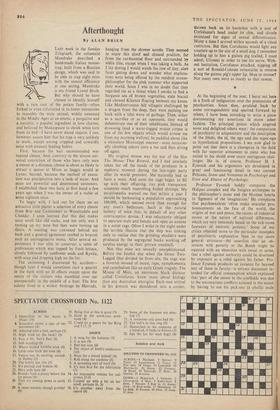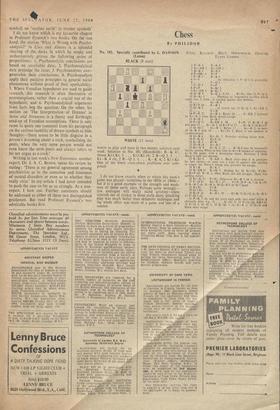Afterthought
By ALAN BRIEN
LAST week in the Sunday Telegraph, the columnist Mandrake described a hand-made Italian mouse- trap, built from a Russian design, which was said to be able to trap eight mice with the utmost efficiency at one setting. Mandrake is my friend Lionel Birch. But why should he have chosen to identify himself
with a rare root of the potato family-often forked or even trifurcated in its lower extremities to resemble the male animal, widely esteemed in the Middle Ages as an emetic, a purgative and a- narcotic, a popular ingredient in love charms, and believed by Shakespeare to shriek when torn from its bed-I have never dared inquire. I can, however, assure him that his trap is very unlikely to work, except among crippled and cowardly mice with unusual feeding habits.
First, because the bait recommended was toasted cheese. And, contrary to the almost uni- versal conviction of those who have only seen a mouse at a distance, cheese is about as likely to attract a queue at Mices as haggis would at Lyons. Second, because the method of execu- tion was precipitation into a tank of water. And mice are powerful and determined swimmers. I established these two facts at first hand a few years ago when I was the owner of a stable of some eighteen mice.
To begin with, I laid out for them on an attractive little platter a selection of every cheese from Brie and Camembert to Wensleydale and Cheddar. 1 soon learned that this diet makes mice smell like old socks, and not only was I turning up my nose but they were turning up theirs. A meeting was convened behind my back and a general agreement ratified to boycott such an unimaginative menu. After several ex- periments I was able to construct a table of preferences which was topped by fresh lettuce, closely followed by sunflower seeds and Ryvita, with soap and dripping high on the list.
The swimming I discovered by accident- though later I would sometimes race a quartet in the bath with no ill effects except upon the sanity of the visitors who stumbled over me unexpectedly in the middle of a heat. The first colony lived in a wicker birdcage by Harrods, hanging from the shower nozzle. They seemed to enjoy this aloof and clinical position, far from the cathaunted floor and surrounded by white tiles, except when I was taking a bath. As I lay dozing I would watch the row of tiny, alert faces gazing down and wonder what explana- tions were being offered by the resident mouse- philosopher for the pink monster who supported their world. Soon I was in no doubt that they regarded me as a threat when I awoke to find a Sargasso sea of brown vegetables, stale biscuit and chewed Kleenex floating between my knees. Like Mediterranean hill villagers challenged by a dragon from the deep, they were pushing me back with a tidal wave of garbage. Theri, either as a sacrifice or as an opponent, they would defenestrate one of their inhabitants. Instead of drowning (and a water-logged mouse corpse is one of the few objects which would arouse me from my morning wallow), he paddled about like a miniature Mississippi steamer-even occasion- ally climbing ashore onto a toe and then diving off again.
My original mouse was the star of the film The Mouse That Roared, and I had unwisely taken her off the hands of the producer in a euphoric moment during the late-night party after its world premiere. She naturally had to have a mate. And soon the cage began to fill up with their offspring, tiny pink transparent creatures much resembling boiled shrimps. My encyclopaedia warned me that within a year I should be harbouring a population approaching 100,000, which seemed more than enough for any man's bathroom. Such is the natural lechery of mice that, in default of any other contraceptive device, I was reluctantly obliged to separate male and female and open an annexe in a metal cage. Often I woke in the night under the terrible illusion that the ship was sinking only to realise that the grinding shudders were produced by the segregated bucks working off surplus energy in their private treadmill.
Not that mice are sexually unsophisticated. Before the fateful day when the Great Two- Legged One divided he from she, the cage was a feverish mound of incest, rape, nymphomania and cannibalism like an early Greek tragedy. The Mouse of Mice, an enormous black dictator called Coriolanus, knew more about biology than any Australian aborigine. Each new arrival in his domain was shouldered into a corner, thrown back on its haunches with a nod of Cariolanus's head under its chin, and closely examined for signs of sexual differentiation. Many a time I arrived within seconds of a ritual castration. But then Coriolanus would fight any creature up to the size of a small dog. I remember holding up to him a guinea pig (called, I must admit, Ulysses) in order to test his nerve. With- out hesitation, Coriolanus attacked, nipping off a sort of Ronald-Colman moustache in reverse along the guinea pig's upper lip. Man or mouse? Not many men were as manly as that mouse.
At the beginning of the year, I burst out here in a froth of indignation over the pretensions of psychiatrists. Since then, prodded back by some correspondents and spurred forward by others, I have been intending to write a piece documenting my assertions in more sober fashion. The principal points which angered some and delighted others were: the comparison of psychiatry to acupuncture and the description of the libido, the id, the ego and the super-ego as hypothetical propositions. I am now glad to point out that there is a champion in the field with far superior armament to mine who has nailed to his shield even more outrageous chal- lenges. He is, of course, Professor H. J. Eysenck and his arguments are developed in great and fascinating detail in two current Pelicans, Sense and Nonsense in Psychology and Uses and Abuses of Psychology.
Professor Eysenck boldly compares the (Edipus complex and the Jungian archetypes to the philosopher's stone and the Moslem houris to 'figments of the imagination.' He complains that psychoanalysts 'often make oracular pro- nouncements on the fate of the world, the origins of war and peace, the causes of industrial unrest or the nature of national differences, which are very tenuously based on the sick-room fantasies of neurotic patients.' Some of my critics objected more to the particular examples of psychiatric explanation than to my more general strictures-the assertion that an ob- session with poverty or the Bomb might be equated with an obsession with sweat or urine, that a rebel against authority could be disarmed by exposure as a rebel against his father. Pro- fessor Eysenck produces an instance far beyond any of these in fatuity-a serious document in- tended for official consumption which explained that 'part of the unrest in the coalfields was due to the unconscious conflicts aroused in the miner by having to use his pick-axe (a phallic male symbol) on "mother earth" (a mother symbol).'
I do not know which is my favourite chapter iii Professor Eysenck's two books. On the one hand, the section 'What is Wrong with Psycho- analysis?' in Uses and Abuses is a splendid clearing of the decks in which he amply and authoritatively .proves the following series of propositions: 1. Psychoanalytic conclusions are based on unreliable data; 2. Psychoanalytical data prejudge the issue; 3. Psychoanalysts over- generalise their conclusions; 4. Psychoanalysts apply their putative principles to general social phenomena without proof of their applicability; .5. Where Freudian hypotheses are used to guide research, this research is often illustrative of preconceptions, rather than a crucial test of the hypothesis; and 6. Psychoanalytical arguments from facts beg the question. On the other, his section on 'The Interpretation of Dreams' in Sense and Nonsense is a funny and forthright send-up of Freudian assumptions. There is only room to quote one comment from his paragraph on the curious inability of dream symbols to hide thoughts-`there seems to be little disguise in a person's dreaming about a cock, symbolising the penis, when the very same person would not even know the term penis and always refers to his sex organ as a cock.'
Writing in last week's New Statesman, another expert, Dr. J. A. C. Brown, opens his review by stating: 'There is no general agreement among psychiatrists as to the causation and treatment of mental disorders or even as to whether they really exist.' In my article 1 had never intended to push the case so far or so strongly. As a non- expert, I bow out. Further comments should be addressed to either of these two distinguished gentlemen. But read Professor Eysenck's two admirable books first.



































 Previous page
Previous page